Developing Self-Care Skills in Children with Disabilities
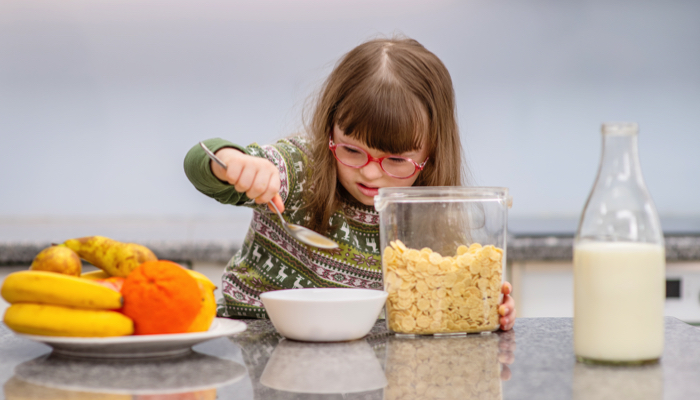
This post may contain affiliate links; please see our terms of use for details.
- Self-care skills generally fall into the four categories: Hygiene, dressing, toileting, and feeding.
- There are many reasons why special needs children may struggle with developing self-care skills, from fine or gross motor limitations to sensory processing difficulties.
- Break down tasks into simpler parts, follow routines, and use adaptive equipment to make self-care skills easier for your child to master!
Most children naturally develop basic self-care skills as they grow and explore the world around them. However, for children with disabilities, this process can be more challenging. While it can be tempting to do things for your child, especially when you see them struggling with a task, it’s important to allow your child to be as independent as possible.
Self-care skills are important for every child to learn, but they can be especially empowering for children with disabilities. By teaching your child how to care for themselves, you’re helping them to gain independence and confidence.
What are Examples of Self-Care Skills?
Four basic categories of everyday life skills, sometimes referred to as activities of daily living (ADLs), are considered a part of self-care:
Hygiene
Personal hygiene is defined as good health habits that help maintain cleanliness and protect against infection and illness. Children typically learn hygiene skills through modeling and instruction from parents and caregivers. It’s important to start teaching hygiene skills early, as kids are more likely to develop good hygiene habits if they learn them at a young age.
Some basic hygiene skills that children should be taught include washing their hands properly, brushing their teeth, bathing independently, and covering their mouths when they sneeze or cough. It’s also helpful to provide simple explanations of why certain hygiene behaviors are important, like explaining that hand washing can help prevent the spread of germs.
Dressing
Dressing is an essential life skill that helps children develop self-sufficiency and confidence. Learning to dress and undress not only builds independence but also gives your child a sense of personality as they develop preferences for certain colors, textures, or styles. Dressing is also an important social indicator as kids create their own style and learn to fit in with friends at school.
Toileting
Potty training is a basic self-care task that causes anxiety for most parents, but parents of young children with special needs can find toileting especially difficult. Learning to use the bathroom without assistance is a huge skill and a big first step toward independence. There are many factors involved in potty training a special needs child, from recognizing and communicating the need to go to the bathroom to independently standing to pull up pants. Any skills mastered while potty training is an accomplishment worth celebrating!
Feeding
Self-feeding is another basic self-care skill that can boost a child’s confidence and independence. Self-feeding can also help children develop fine motor skills and hand-eye coordination.
As children age, self-feeding skills will include using different utensils, cutting food independently, making simple meals, and even packing their own lunch box for school.
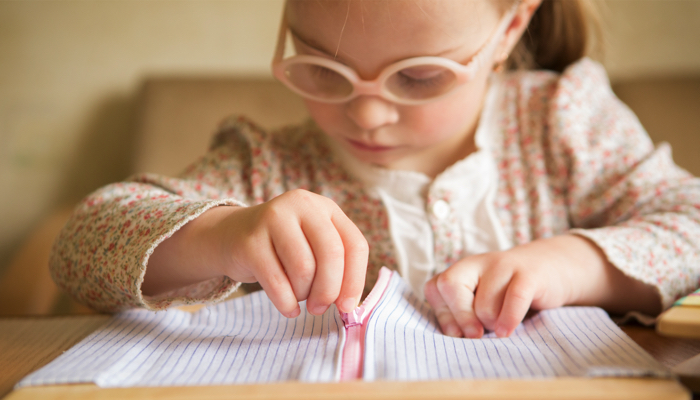
Why Might Children with Disabilities Struggle With Self-Care Skills?
All kids are different and develop at their own pace, but this is even more true for kids with special needs. Depending on your child’s specific diagnoses and challenges, some aspects of self help skills may be easy and others much harder to achieve.
Fine and Gross Motor Limitations
Many children with special needs and disabilities have problems with fine and gross motor development. This can impede their ability to perform everyday tasks like brushing their teeth or buttoning their shirt.
Fine motor skills involve the use of small muscles, such as those in the hands and fingers, to perform tasks like writing or picking up small objects. Gross motor skills involve the use of large muscles, such as those in the legs and arms, to perform tasks such as standing, walking, or running.
Sensory Processing Difficulties
Many children with special needs experience difficulties with sensory processing. This refers to the ability to take in, organize, and respond to information from the senses. For some children, this can mean that they are over-sensitive to certain stimuli, while others may be under-sensitive.
As a result, children with sensory processing issues often have trouble with daily living activities like eating, dressing, or bathing. In addition, they may be easily distracted or have difficulty paying attention, making it harder to learn new skills.
Limited Motor Planning
Children with special needs may also have difficulty with motor planning, meaning that they have trouble figuring out how to move their bodies in space in order to complete an action. This can be due to a number of factors, including muscle weakness, poor coordination, brain disorders, and sensory processing issues.
For example, a child with limited motor planning might have trouble putting on a shirt or bringing a spoon to their mouth because they find it challenging to plan out the specific movements necessary to complete the action. While all children go through a period of development where they are learning how to control their own bodies, children with special needs often have greater difficulty with this process.
Low Motivation
We might not want to admit it, but sometimes our kids with disabilities aren’t advancing in their development because we do too much for them. It’s often easier for us parents to just put on our kids’ shoes, get them dressed, and feed them ourselves. And the reverse of this equation is that it’s also easier for our kids to let us do things for them. Take a step back when you can and see if your child can find more motivation to learn important skills. They may surprise you!
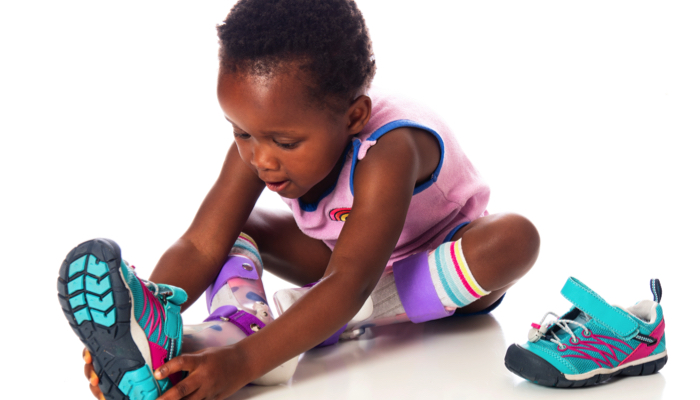
At What Age Should My Child Master Self-Care Skills?
All children develop independence at their own rate, but it’s also good to know when kids should generally achieve self-care skills and reach their developmental milestones. According to the Center for Speech, Language, Occupational Therapy, and Applied Behavior Analysis, between the ages of 18 months and 8 years, parents should see significant advances in self-care skills.
The chart below will let you know if your child is displaying self-care difficulties and what areas you need to focus on:
| Hygiene | Dressing | Toileting | Feeding | |
| 18 months | Following simple directions to hold out arm or leg when dressing | Showing discomfort when wet, sitting on the potty with supervision | Finger feeding small bites and drinking from sippy cup | |
| 2 years | Washing hands and brushing teeth with assistance | Removing socks, pants, shirts without fastners | Needs help getting to the potty, but having fewer accidents | Eating with a spoon, drinking with a straw |
| 3 years | Hand washing independently, washing face | Dressing with assistance, unzipping zippers, fastening large buttons | Mostly independent on the potty, may need help with wiping and dressing | Stabbing food with a fork |
| 4 years | Brushing teeth, washing face, brushing hair independently | Dressing and undressing independently | Fully potty trained | Mostly feeding independently, needs help cutting food |
| 5 years | Needs help bathing | picking out clothes, tying knots and laces | Cutting food with a knife | |
| 8 years | Bathing fully independently | Preparing simple meals, packing lunch boxes independently |
7 Tips for Promoting Self-Care Skills for Children with Disabilities
1. Give lots of opportunities to practice self-care tasks
When teaching your child self-care skills, it’s essential to provide them plenty of opportunities to practice the new tasks they are learning. At-home or school-based therapy sessions allocate time with a professional to go over skills, but actually performing a task in real-life conditions is very different. For example, when my son was working on his walking skills, he would walk back and forth in his physical therapy sessions, but this didn’t really hold much meaning for him. Having him walk from his bedroom to the dining room for breakfast, on the other hand, was much more meaningful and motivating.
Try to create a daily routine or schedule that allows lots of extra time to work on self-care. If you’re focusing on hygiene, be sure to give yourself extra time in the bathroom for hand washing or cleaning teeth so your child can do as much independently as possible without feeling rushed.
2. Follow routines and a daily schedule
Speaking of routines, stick to them! Create a visual or tactile schedule for your child to follow so they know what to expect and, most importantly, what tasks they will have to complete on their own. As your child becomes more independent, the goal is that they will be able to consult the calendar themselves and finish tasks without being asked.
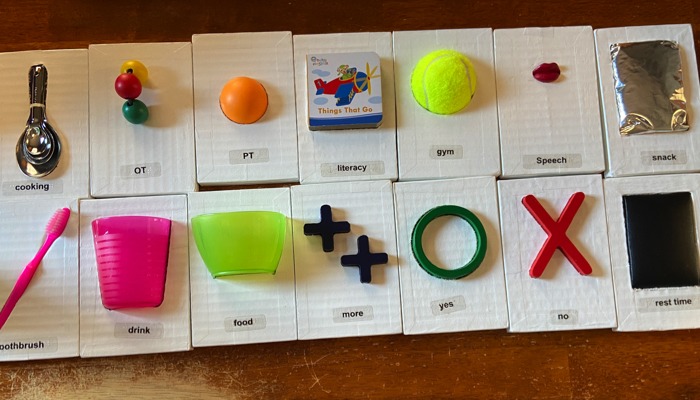
We’ve used object calendars with my son for years now, and they are great accessible tools to establish the routine for the day. Object calendars use real objects to represent tasks or activities, like a toothbrush to represent teeth cleaning or a cup to represent drinking. These objects are glued to small cardboard rectangles that can be stuck to a larger board with velcro.
You can also add large print or braille to the objects if your child is learning to read. You can make these yourself or use the Standardized Tactile Augmentative Communication Symbols Kit (STACS) from APH, which are easier to use and standardized, so your child may encounter these symbols in school or therapy sessions too. These symbols are expensive, though, so talk to your child’s TVI about utilizing Quota Funds to buy them.
3. Break down a task into simpler and easier parts
Breaking down a task into simpler and easier parts can make big life skills seem less overwhelming. Occupational therapists will often suggest forward chaining or backward chaining, referring to the process of breaking up a task into small parts, then teaching the easiest part first.
For example, instead of teaching your child to brush their teeth all at once, you could break this up into
- holding a toothbrush,
- wetting the toothbrush,
- squeezing toothpaste onto the toothbrush,
- moving the toothbrush in a circular motion on the teeth.
These skills build in complexity, so this is considered forward chaining, where each skill gets more difficult and builds toward completing the task.
Some tasks begin with more refined physical control required, then build to easier movements, so in that case, you would utilize backward chaining and teach the last step first.
4. Utilize adaptive equipment when possible
There are a number of products designed to help people with disabilities complete basic self-care tasks. From adaptive utensils to three-sided toothbrushes, if it can make life easier, use it!
If your child is struggling to perform a particular task or is having difficulty tolerating certain seams or textures, there’s a pretty good chance someone has created a product to help solve that problem. Check out this list of our favorite tools for teaching self-care skills!
5. Have necessary materials available during daily tasks
If your child is practicing a new skill, make sure that they have everything they need within reach. For example, if they are learning to brush their teeth independently, set a small toothbrush caddy on the bathroom sink with their toothbrush and toothpaste together. Make things as easy for your child as you can! If they often knock things over while performing a task, opt for containers with suction cups or magnets or add velcro to objects so they stay in place and are easily accessible.
- Set includes (3) different sized suction bowls with a new, modern look and improved suction
- Strong suction base helps prevent messes and spills
- Quick release tabs on each suction base allow for easy parent removal
- Microwave and top rack dishwasher safe, BPA free
6. Promote independence with simple materials
Who says pants need to have buttons? Or that socks need to go in a certain direction? Kids thrive on success, so make achieving success easier by choosing simpler options. We opt for elastic pants that can be easily pulled on and off and skip the buttons and zippers altogether. Seamless socks are never on backward, and round bristle hair brushes are always held in the correct orientation. As your child masters each skill, you can move on to more complex tools, but start simple and celebrate the successes!
- TRULY SEAMLESS – Does your sensitive child have morning meltdowns due to socks? Completely free of seams, this product made in the USA is knit like a caterpillar spins its cocoon from the toe up, eliminating all lumps & bumps and providing a comfortable fit.
- UNIQUE NO HEEL DESIGN – This “no heel” design allows kids to put on their socks with confidence and provides a perfect fit every time.
- SOFT & FORM-FITTING – The stretchy yarns result in a form-fitting design that eliminates wrinkling and bunching at the toes, making it great for children with sensory issues.
- COMFORTABLE, NON-BINDING TOP – The non-binding Halo Top means no slipping down or irritating indentions on the ankle.
7. Seek help from special needs therapists
Sometimes extra practice at home can only get you so far. Look at your child’s IEP or IFSP and see if you can add more hours with an occupational therapist in order to work on more self-care skills. Insurance will usually also cover outpatient sessions with a therapist in a clinic or hospital setting. Additional speech therapy services can also help as a big part of completing these tasks is the ability to communicate basic needs, such as needing to go to the bathroom. Speech therapists are often also trained as feeding specialists and can help your child develop their oral motor skills.
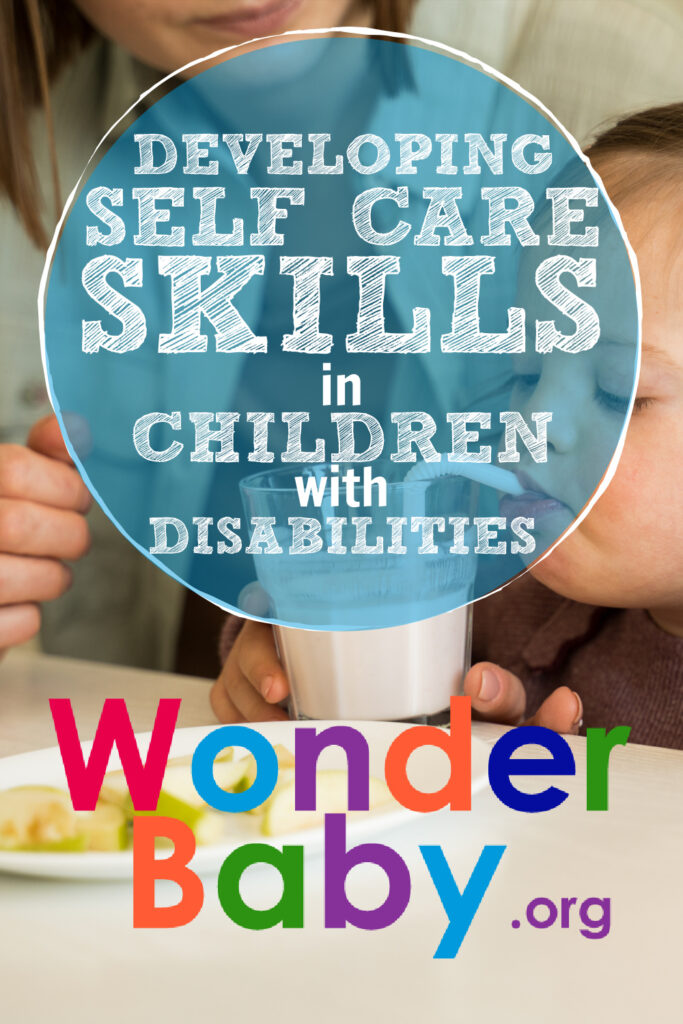
Related Posts

Special Needs, Support
How Do You Keep Faith Alive When Your Child Remains Ill?
I understand the emotional toll of chronic illness, but I also believe in the power of faith and community to uplift and sustain us.
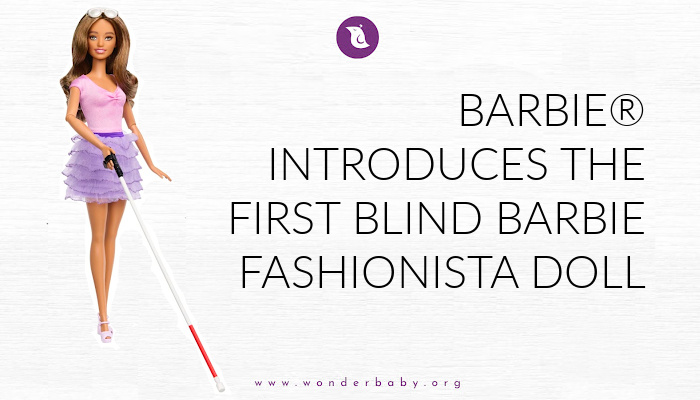
Toys, Visual Impairment
Barbie® Introduces the First Blind Barbie Fashionista Doll
Mattel, in partnership with AFB, announced the addition of a blind Barbie doll with white cane and sunglasses.
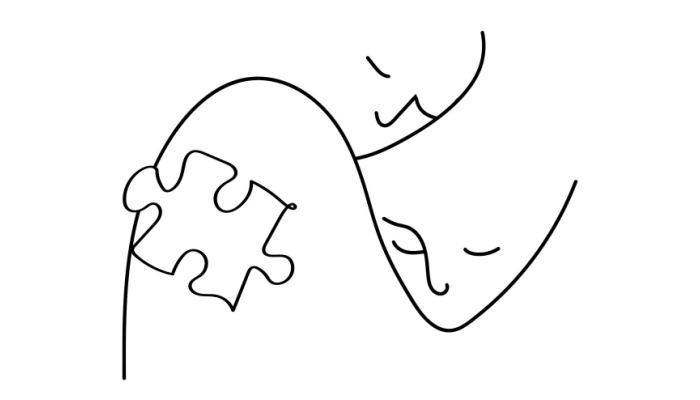
Autism
When Autism Advocacy Goes Wrong: Supporting Parents of Profoundly Affected Children
If you’re not personally affected by autism or don’t work with autistic individuals, you might be unaware of the growing debate within the autism community.

